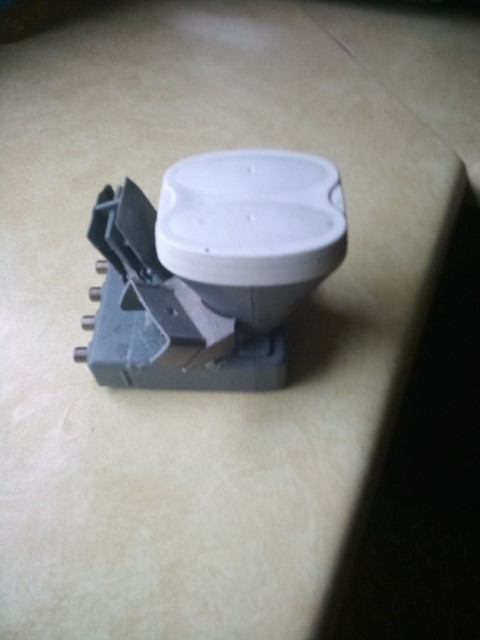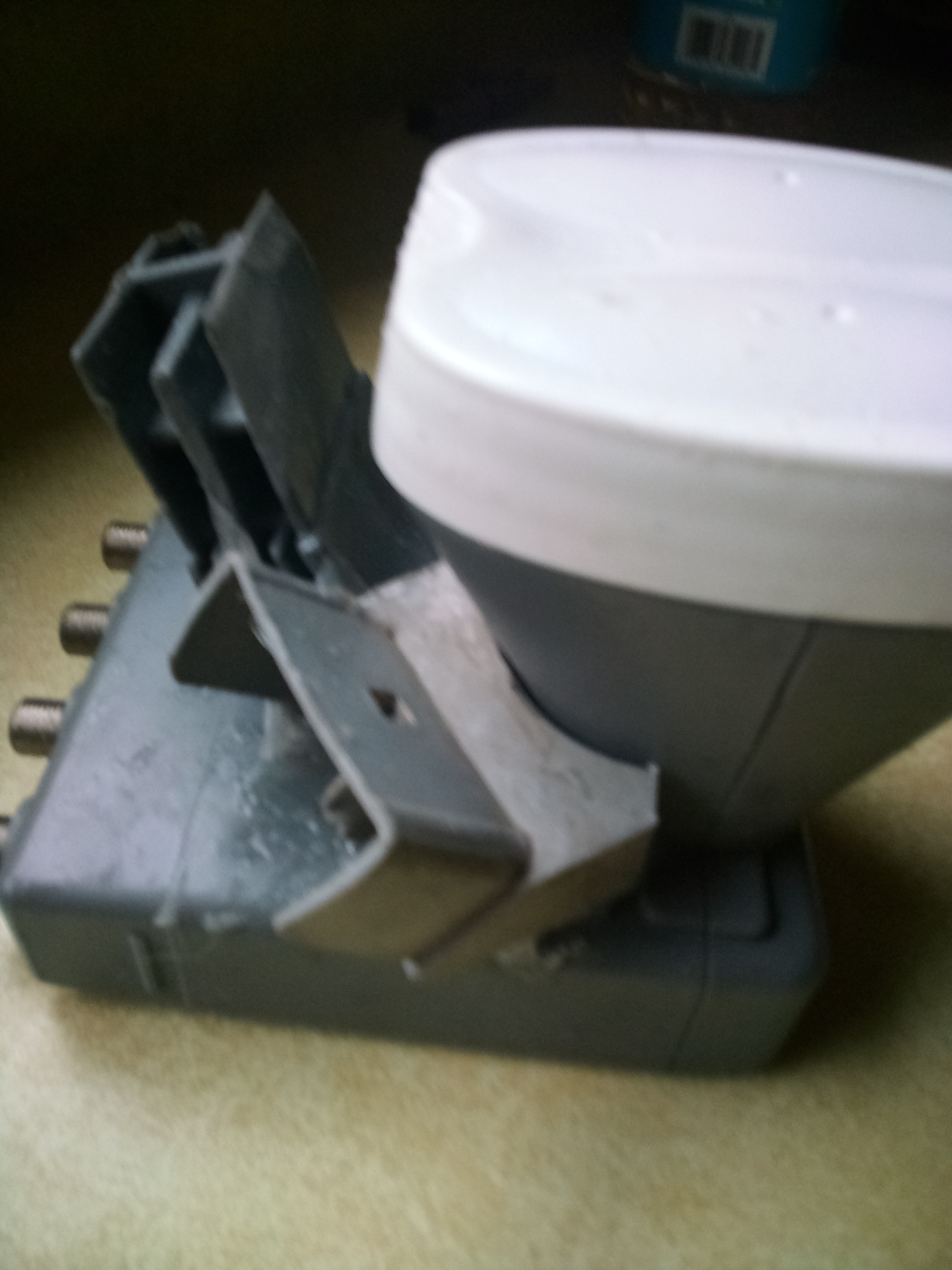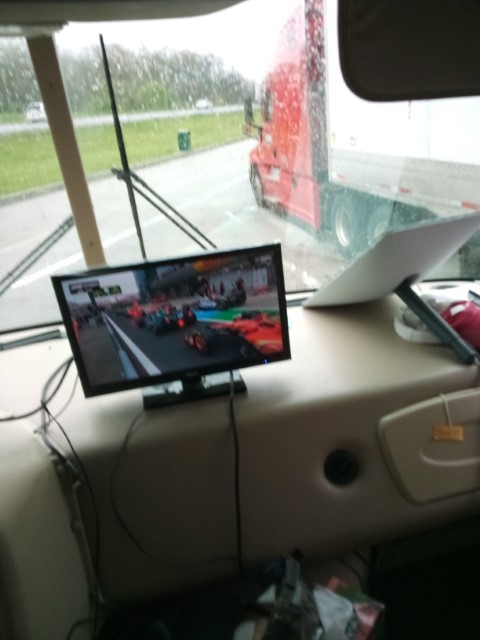
There are two satellite TV services available in Canada,
Bell and Shaw Direct (Rogers). Bell dishes are smallest
(18") and
because their technology is the same as USA, simple roof mounted dishes
are available for
RV's. But as of Feb 2024 neither one works in USA. Both services still work in Canada.
The manual rooftop dishes available from RV dealers will work on Bell in Canada without modification.
The Shaw Direct dish is larger and
elliptical, and
only motorized automatic roof mounts are available commercially for
RV's. Manual dishes will only work on Shaw (Rogers) in Canada with modification.
I provide details on how to build your own manual rooftop Shaw Direct
dish in a later pararaph.

As part of the Shaw Direct equipment upgrade, a new satellite G1 has been placed in orbit at 107.3W. It has an antenna pattern which cannot be seen by users in the USA. All channels are now on this single satellite, which now makes aiming easier.
t should be noted that a stronger signal is need to receive MPEG-4, and the smaller 60E dish may not be adquate for US signal reception. The larger 75E mobile dish is recommended. Still, signal loss due to rainout or dish movement will be more common and last longer.
To reach information on Receiver setup. Hit the Options button at the bottom of your remote (next to 0) Press Options-4-7. For more information then hit "Info" . This opens a selections of screens with more details.
VE3LGS EASY METHOD for aiming dish with GARMIN GPS
I recently purchased a small handheld Garmin Nuvi GPS. This has main highways down to backwoods road maps built in for most of North America. Really handy in unfamiliar towns. You can drive straight to a laundromat in Arizona or a Beer store in Ontario. By the way, if you are a real boondocker, you will soon find out that the GPS application for your Iphone or Android won't work unless you have a good Cell signal. This happens all too often.
Anyway, I digress.
What is really helpful for satellite aiming, is its built-in
ability to calculate
great circle distance and bearing to any point on earth. As far as I
can tell, this function is only available with a Garmin GPS.
Enter the location of your satellite into your GPS favourites
list. In the case of the Shaw Direct primary satellite it is 0.0 deg N,
107.3 deg W. Name it and
save.
Now set your System/Settings/Units to kilometers. Every time you
require the
aiming information for this satellite go to your favourites list, page
down to
that satellite. Write down the distance from your location in km. and
bearing given.
Divide the distance by 100 and subtract from 88. This is the elevation
angle.
Easy.
If you want the direction of the satellite set tools/navigation to "OFF ROAD" and the magenta line is the bearing.
EXAMPLE CALCULATION
In my case, from home, this is 5772km@SW. Subtract 57.72 from 88 gives
30.28.
Set your dish elevation to aprox 30 deg and point South West.
If your mounting post is vertical, rotate to peak signal and you will
be watching TV.
* Simple Dish Tripod
In forested campgrounds, we look for shade and this
means we must use a tripod mounted dish, to clear trees. For a
lightweight Tripod use a cheap plastic camera tripod. Remove the
Camera head, and replace with a 1 1/4 inch ABS PIPE hose clamped to
the center column. I glued a bubble level to the top of the ABS pipe
and this gives me one less item to find, and setup is easier.. Adjust
level bubble
by adjusting leg length on tripod.
* I have two cables, 30 ft and 50 ft. Only once in North Maine woods did I need more to clear the trees and had to move to a different camp.
* Use RG59 Coax if you are going to be moving often, RG6 if more permanent. RG59 will eventually pick up water and develop more losses than RG6. You can tell this is happening when the higher numbered transponders start losing signal strength. New coax should fix it or buy one of those inline satellite preamps from Radio Shack. Remember, it must be inserted out at the antenna to do any good.
* Change the dish elevation nuts to wing-nuts, or those black threaded
knobs
at Tractor Supply to make
elevation adjustment easier.
* Keep the pipe clamp slightly slack to allow slip fitting the dish onto the mount. They do not really need to be tightened for camping setups when travelling with only short stops.
* On the side of your dish mount is an engraved scale for elevation setting. The standard Expressvu dish uses a line forward of the adjust bolt as a setting point, while the Shaw Direct dish uses the bolt center line. Check your manual.
* I also do not install the LNBF head bolt so I can store the LNBF separately. Just have a short 3' coax attached to the LNBF which I slip into the arm.
* The 3'junction provides a place to connect a Satfinder meter (available from Radio Shack). This Satfinder is a must have, to save setup time.
* Remove the Satfinder after setup to give you 5-8 more Strength units.
* I use slip on connectors at the meter joint to make connections even faster.
* It is also possible to drill out one of the spot welds on opposite sides of the LNB arm and insert a bolt, to make a folding arm. I used the lower one so that the dish and arm lay flat, face down, stretched out, when stored. Use the upper one if you want to fold the arm against the dish. The remaining pair of spot welds are then used as detents, or insert a cotter pin to hold the folding arm in the correct position when set up to receive. It works well.
With the elliptical dish the arm is removed simply with one bolt and can then be stored flat.
* I use three plastic topped "nail like" tent pegs from Canadian Tire to spike the tripod to the ground and keep the dish from toppling over in the wind. Hook them over or drill holes in the the leg braces and hammer into the ground. Use Rocks in places with no soil like North Maine or Newfoundland. Screw anchors only work in some soil, and the bungee cords usually supplied are too stretchy in high winds.
* If you are having problems with tree branch or other interference, try sighting the beam. Look out along either side of the dish arm, sighting a line from the bottom of the dish to the top of label on the LNBF arm (up 1-2"). This gives a very good approximation of the view which is slightly offset upwards from what appears to be the dish centre. Sighting will make it easier to know where to move to miss a tree branch. We often use this trick to find that narrow hole in forest cover with the only view of the satellite. (Easier in South USA than Canada because of the higher angle.).
* If you want to try a temporary roof mount, use a piece of 1 1/4" ABS pipe and hose clamp it to your ladder so that it stands vertical when you are level. Pop the dish onto this pipe when parked ( preset at the correct elevation angle) and rotate to peak the signal. Lock in place securely because your wind exposure is much higher at rooftop.
* All Shaw Direct receivers will work directly on 12
volt, even the PVR. Remove the provided power block and buy a
12 volt cable with the correct adaptor. These are available from anazon
or Radio Shack in the USA.
BIRDBATH MOUNT for SHAW DIRECT

I have another dish mounting arrangement which I use when it is windy, a common problem out west in Arizona. I call it the "Birdbath Mount". It works well and is easy to aim.

HOW TO BUILD A MANUAL ROOFTOP Shaw Direct DISH
The Shaw Direct dishes in general are larger and need much
more alignment because the signals are linearly polarized. This also
makes the use of
RV rooftop mounted antennas, difficult because as you travel west the
skew has to be changed manually to match the viewed polarity of the
satellite antnnas. But I have
mine working in case you want to try. I bought an
Antenna-Tek RV Manual
Dish and removed the supplied 18 inch dish and arm for
Bell TV.
In it's place, I mounted a 24 inch round Star- Choice dish. Two bolt
holes
almost line up, just needing slight hole elongation of the bracket. For
the other two, new holes must be drilled in the dish.
Using the arm from the Shaw Direct dish
I cut off 1 3/4 inches, Drilled a pivot hole and mounted the LNB. To
set
the correct arm angle of 75 degrees to the dish I attached two
wire-rope 3/16 inch bulldogs around the stop bolt. Rotating the stop
bolt rotates the bulldogs which act like a cam to set the angle. Make a
template of the Dish and arm before you dismantle the existing dish and
use it to set the angle on the new installation.
You may have to try a few Shaw Direct dealers
to find an old working dish. They usually scrap them, but some still
have a junk pile of dishes replaced by the newer dual satellite
elliptical dishes.
I have modified a standard Shaw dual X-Ku LNB for use
with a round dish by glueing a second offset bracket to the LNB at an
angle of 15* deg (skew for Ontario) and centered on Section "A" of the LNB. This will to shift the aim of the "A" LNB to
hit the centre of the dish. See the Photo.


Good luck and let me know of your success.
I have used my Manual rooftop installation for 20 years across Canada, Alaska, and Southern Florida. In Inuvik, NWT, we watched the latest "Ice Road Truckers" while all US systems, and Expressvu would not work..
The elliptical dish is tricky to aim, and if you can get an older round dish, it has more gain and is much easier to hit one satellite.
If all this is too much,
Use a tripod and learn how to point manually.
I again suggest purchasing a tuning meter to give you an idea of when you are close.

If you still want to watch Canadian TV when in USA, I suggest
streaming. This requires a data contract over cell towers or a data
contract with Starlink. I use a combination of both Rogers and
Starlink. Rogers is not always dependable, and the contract only allows
100GB per month at speeds needed for streaming. When I can I put
Starlink on pause, but carry the equipment to be ready when needed. I
have a sim card router which can connect direct with my cell service.
And the Starlink router has been bypassed and feeds my router which
allows "failover" to Starlink in case of loss of cell service. The
Starlink antenna has been opened up, and the nuisance motors have been
unplugged. That saves current demands on the 12 Volt battery, when
boondocking. It also permits me to lay the Starlink antenna on my
dashboard and view the sky from there. Without needing to setup
outside, I save time. I can stop, watch something important, then move
on. Here is a photo showing a Formula 1 race from China, while stopped
in an Interstate rest area. The Starlink antenna is on the right. This
trick also works in overnight Walmart stops.
Another Satellite service which makes your day in the outback with your
motorhome a lot more pleasant is Mobile Satellite Radio
With this system you won't be always tuning for your choice of radio
station
as you cross the country. Have a look next time you are in Best
Buy $100-200 for equipment and $10-$12 per month for service.
I like the idea of FM output so that the existing vehicle radios can be
used to listen without mods. It also means you can have the RV parked
in the driveway and listen on the house radio.
Both Sirius and XM now broadcast to Canadians
While XM has sold more sets, it is my opinion that the Sirius system
which uses
satellites in elliptical orbits may offer better service for Rvers in
more places than XM. With XM you need to be able to see the satellite
"hot spot" to the south over the equator from your location and this
will always be more difficult than receiving
any one of the several Sirius satellites moving directly overhead. XM
does not work well in the north while Sirius has good coverage to
Whitehorse.
but signals are lost for a few hours a day as you travel north to
Alaska.
I have had a lot of feedback on this problem and most users complain of
signal
dropouts from tree or building interference when deep into Canada. XM
may be workable only if carefully parked in Newfoundland or Yukon so
they are going to have lots of technical
problems. My best bet for complete mobile coverage would be Sirius.
Good in Newfoundland, and most of the day
in Yukon/NWT/Alaska.
XM gets hard to get in Northern Quebec at James Bay, but is useable
when parked. It is a good thing the trees
are short there.
QUICK INDEX
DOS WEB
DOS EMAIL
RV
SATELLITE
RV
BOONDOCK
RV SOLAR